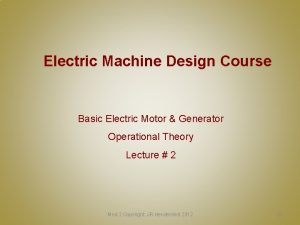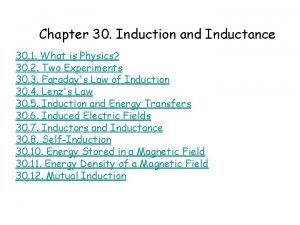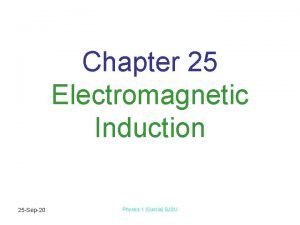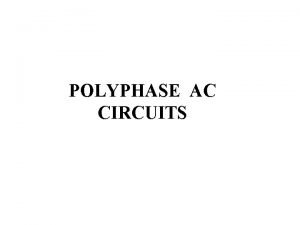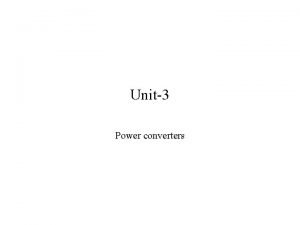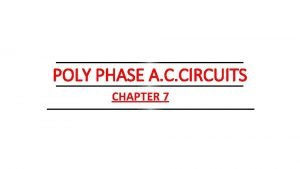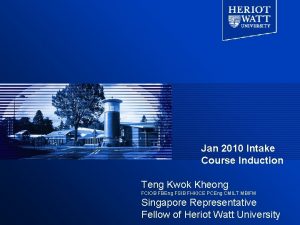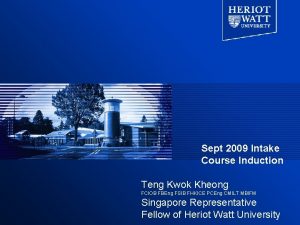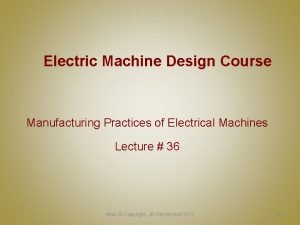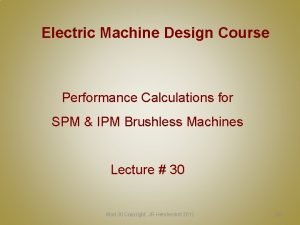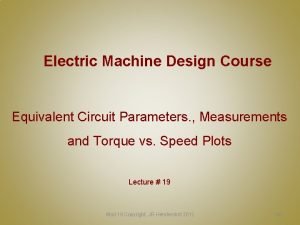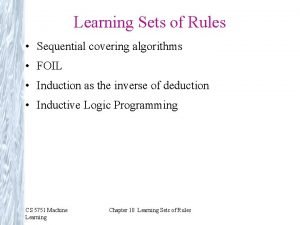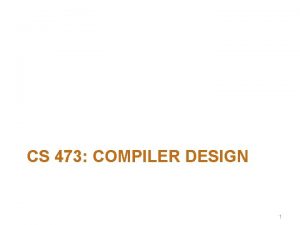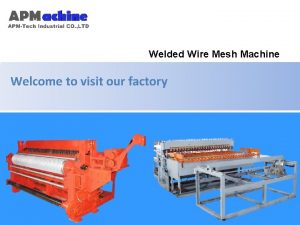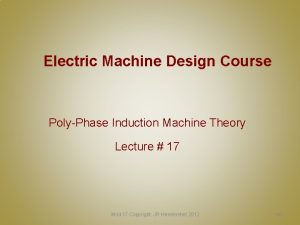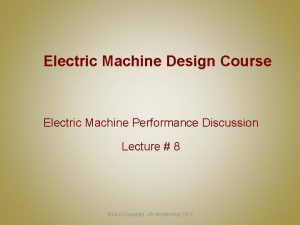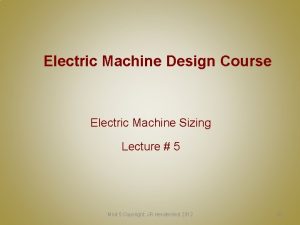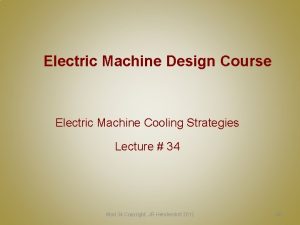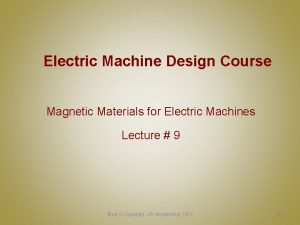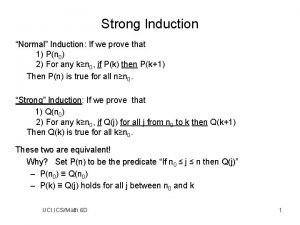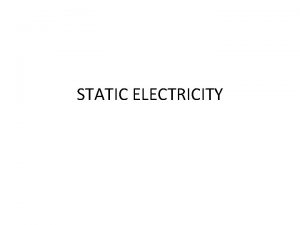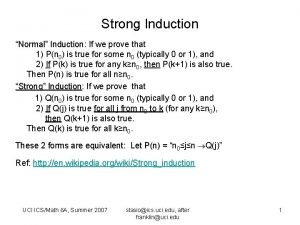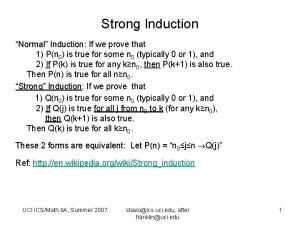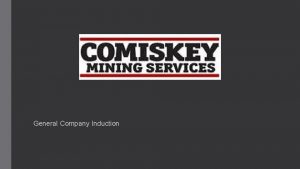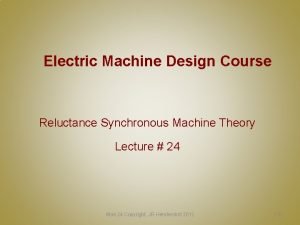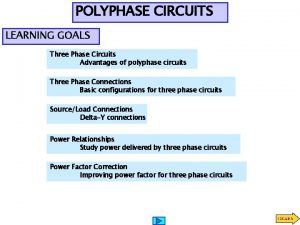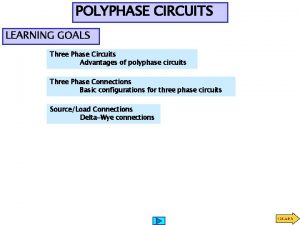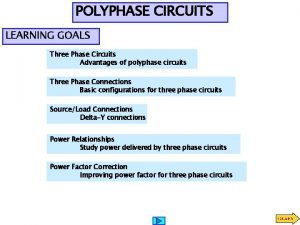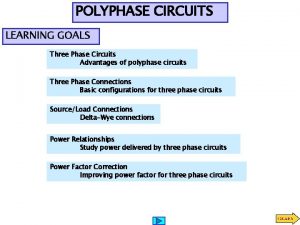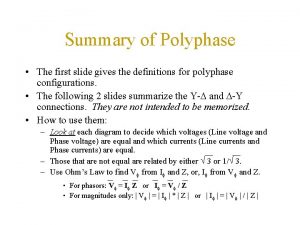Electric Machine Design Course PolyPhase Induction Machine Design




























- Slides: 28

Electric Machine Design Course Poly-Phase Induction Machine Design Strategy Lecture # 18 Mod 18 Copyright: JR Hendershot 2012 160

Proposed IM design steps for field oriented control 1 - Size machine according to lecture # 5 starting with Stator O. D. & TRV 2 - Assume pole number, desired P. F. & efficiency than estimate rotor volume 3 - Determine air-gap length between rotor & stator/side. 4 - Estimate number turns per phase. 5 - Select number stator slots (Divisible by number of phases, no remainder) 6 - Select stator coil current density & select wire gage 7 - Select stator tooth dimensions for acceptable flux density. 8 - Assume 40% slot fill factor & determine slot depth 9 - Check stator yoke flux density & iterate slot depth and tooth width, 10 - Calculate mean turn length of phase coils 11 - Calculate coil resistance & phase resistance (iterate if necessary) 12 - Select number of rotor slots (at least 6 per pole) 13 - Decide if rotor is skewed or not. 14 - Select rotor bar current density 15 - Determine rotor bar shape, (thickness and length) 16 - Calculate rotor bar and end ring resistances. 17 - Calculate magnetizing inductance and current. 18 - Calculate leakage inductance 19 - Calculate rotor leakage inductance 20 - Use FEA analysis to check for flux densities and distributions 21 - Calculate iron losses, assume windage & friction 22 - Use these results to solve equiv. cir. and compare with original assumed 23 - After iteration is complete solve for efficiency and power factor at desired loads Mod 18 Copyright: JR Hendershot 2012 161

Steps #1 & 2 , Sizing machine, P. F. & Efficiency Start with maximum stator O. D. (refer to existing machine listings*) Select number of poles (Usually four if torque less than 100 Lb-Ft) Select estimated core lengths based upon the number of poles. Select TRV & gap stress based upon duty severity and cooling Set efficiency and power factor goal Rotor D/L ratio = F. Fu and X. Tang, Induction machine design handbook: China Machine Press, 2002. Number of poles (2 p) Mod 18 Copyright: JR Hendershot 2012 162

Suggested TRV & gap stress sizing guidelines 10 k. Pa = 1. 45 Psi Prof. TJE Miller Mod 18 Copyright: JR Hendershot 2012 163

Typical power factor & efficiency of (3) phase NEMA B IM machines vs. poles & frequency All data based upon 60 Hz RPM Poles Prof. Tom Lipo 512 14 600 12 720 10 900 8 Mod 18 Copyright: JR Hendershot 2012 1200 6 1800 4 164

* Existing (4) pole IM machine dimensions of rotor & stator cores (ATE) ATE Germany Mod 18 Copyright: JR Hendershot 2012 165

* Existing (6) pole IM machine dimensions of rotor & stator cores (ATE) ATE Germany Mod 18 Copyright: JR Hendershot 2012 166

* Existing (8) pole IM machine dimensions of rotor & stator cores (ATE) ATE, Germany Mod 18 Copyright: JR Hendershot 2012 167

Steps # 3, 4 & 5, Air-Gap length, number of stator slots & turns/phase Air-gap length needs to be as small as possible but also must be practical for manufacturing. Best beginning strategy is to use gaps from existing machines form lists provided. Stator slot selection can be based upon past practices but old rules for combinations can be ignored for inverter fed IMs. (see Reliance-Baldor list) Turns per phase based upon machine size, current available and NI required to produce gap flux density of about 0. 85 Tesla. Mod 18 Copyright: JR Hendershot 2012 168

Air-Gap selection guidelines Larger air gap increases magnetization (reduces efficiency) Rotor to stator contact avoidance determined by rotor bearing system Suggest use Industry air-gap practices for AC Induction machines Select based upon analytical factors: Magnetizing current, pulsation losses Mechanical tolerances, bearing, shaft deflection Radial unbalanced magnetic forces Large side loads applied to extended output shaft Air-Gap thickness does not seem to significantly effect audible noise Mod 18 Copyright: JR Hendershot 2012 169

Empirical air-gap calculations Lipo’s chart of gap vs. pole pitch Lipo’s method: p 8 p g Say’s method: Suggestion: Should apply to RSM machine air-gap but not as yet proven. 2 p 4 p 6 p 8 p 16 p Mod 18 Copyright: JR Hendershot 2012 Pole Pitch (in) Poles = 2 p Air-gap = g 170

Phase current requirements for IMs The phase currents provide magnetization of the rotor plus the flux linkage with the stator. Volts/phase in stator Total Flux = If air gap flux density, is 35 to 55 Klines/sq-in (about 0. 85 Tesla) Total flux = Design of Electrical Apparatus, by Prof John H. Kuhmann Mod 18 Copyright: JR Hendershot 2012 172

NI requirements for IMs Amp-Turns/pole required to send flux across air gap: ATP = NI/pole to magnetize circuit B = lines/in-sq. g = air gap (in) Ks = Carter coef. ATP= ATg + ATts + ATtr + ATys + ATyr Effective magnetizing current/phase = Turns/ coil is determined by voltage, power & current. (Turns/coil varies directly with voltage) Mod 18 Copyright: JR Hendershot 2012 173

Calculate number of turns per coil Calculate number of stator turns per phase depending on previous B, D, L, supply voltage (math) and assumed flux density shape fa Flux per pole Bg = 2 p Φm/(πDL) to find Φm KE: typically 0. 85 -0. 95, higher for large power rating or small pole number Back EMF factor Turns per phase Kf : form factor, typically assumed = 1 Kw 1 : winding factor fundamental = typically 0. 955 f : fundamental frequency Mod 18 Copyright: JR Hendershot 2012 174

Strategies for number turns per coil Frequently less than a single turn/coil adjustment is desired for performance. Parallel circuit paths offer the option of effectively achieving fraction turn changes Four turns/coil with one current path can be adjusted to 4. 5 turns per coil with two parallel current paths and 9 turns per coil. . Another strategy to achieve ½ turn adjustment is to connect the phase neutral on the opposite side from the phase lead connections. This also reduces the end turn height bundle on the lead side of the stator by moving the neutral connection bulk to the opposite end turn side. These comments apply to all machines types discussed in these lectures. Mod 18 Copyright: JR Hendershot 2012 175

Steps 6, 7, 8 & 9 Determine stator slot to tooth dimensions, slot depth & densities of current and flux From initial current and flux estimates the slot & tooth densities can easily be determined by dividing be the respective cross sections or solving for dimensions based upon accepted densities. Note the tooth flux density is based upon the total air gap flux divided by the number of stator teeth per pole. The stator yoke must support half of the gap flux per pole because the tooth flux splits into two paths so the yoke cross section area is one half (or more) than the teeth cross section per pole. Slot depth changes has a greater affect on slot area more than slot width adjustments & higher tooth flux densities are more acceptable than high yoke flux densities with respect to iron core losses. Mod 18 Copyright: JR Hendershot 2012 176

Typical phase conductor current densities Mod 18 Copyright: JR Hendershot 2012 177

Flux density guidelines by two experts Select suitable values of flux density in stator back iron and compute stator outer diameter. (for 60 Hz, ordinary electric steel, lower for higher frequencies) Position Typical flux density range (Say) Maximum flux density (Lipo) Airgap Bg 0. 65 – 0. 82 T (ave. ) Stator yoke 1. 1 – 1. 45 T (peak) 1. 7 T Stator teeth 1. 4 – 1. 7 T 2. 1 T Rotor yoke 1. 2 T 1. 7 T Rotor teeth 1. 5 – 1. 8 T 2. 2 T Mod 18 Copyright: JR Hendershot 2012 178

Steps #10 & 11, Phase coil mean turn length & phase resistance The resistance of each coil is determined first and then the phase resistance Determine the mean turn length first from the center path of each turn. Multiply the MTL times the number of turns/coil times the wire gage resistance per inch or mm. The phase resistance is the sum of the coils in series per phase or the sum of the reciprocal of the coil resistances in parallel per phase. When a combination of series & parallel coils result Ohm’s laws are applied. Mod 18 Copyright: JR Hendershot 2012 179

Calculate stator winding resistance (approx. math – end turns) Resistively of conductors (look up in gage table) Estimate end length lend Conductor cross sectional area (standard wire gauge) Stator resistance Harley & Duan Mod 18 Copyright: JR Hendershot 2012 180

USA Wire gage chart with resistance/meter Mod 18 Copyright: JR Hendershot 2012 181

Steps #15, 16, &17 Select rotor bar details, number, shape and resistances of bars and end rings Number of rotor bars and shape must be based upon minimizing leakage inductance and cage resistance. (ignore old rules) Number of bars should not be less than 6 bars or slots/pole For IMs with pole numbers greater than (4), consider 7 to 9 bars/pole To minimize leakage inductance position bars close to rotor O. D. Bar shapes can be parallel sided for large machines or tapered for smaller machines. (Double bars not advised for inverter IMs. ) Use of copper bars & end rings permits lower cage resistance Bar retention and stability must be considered with bar design. 8 Mod 17 Copyright: JR Hendershot 2012 182

Rotor Leakage Permeance vs. Rotor Slot Shape Suggested Rotor slot proportions: 8 Mod 17 Copyright: JR Hendershot 2012 & 183

Rotor bar considerations for inverter driven IMs Typical bar shapes for grid powered IMs Principle design criteria is improving starting torques Typical bar shaped=s for inverter powered IMs Principle criteria are low leakage inductance & resistance Mod 18 Copyright: JR Hendershot 2012 184

Cage resistance calculations Divide bar number by number of poles for bar resistance and use bar cross section and Al or Cu resistivity to calculate bar resistance. End ring radial cross section where intersecting bars can be used to calculate end ring resistance. Extra end ring thickness assures lower current density in end rings than current density in bars which attracts heat form Ohmic losses from bars into spinning end rings. For fabricated copper rotors copper bars are used with bronze end rings. Sometimes steel end rings are added to copper end rings for balancing and rotor stability for high speed machines. (ignore steel cross sections) Mod 18 Copyright: JR Hendershot 2012 185

IM operation envelope (motor & inverter) Desired performance must be contained inside envelope of family of T vs. f curves Each plot is at fixed voltage & frequency Note: Torque vs speed plot has been corrected Siemens Mod 18 Copyright: JR Hendershot 2012 186

Steps # 17 through 23 covered in Lecture 22 Mod 18 Copyright: JR Hendershot 2012 187

Mod 18 Copyright: JR Hendershot 2012 188
 Electric motor design course
Electric motor design course Induced current
Induced current Electric generator electromagnetic induction
Electric generator electromagnetic induction For a star connected three phase ac circuit
For a star connected three phase ac circuit What is polyphase rectifier
What is polyphase rectifier What is a polyphase system
What is a polyphase system Course induction ntu
Course induction ntu Disguises by jean fong kwok
Disguises by jean fong kwok Electrical machine design course
Electrical machine design course Spm machine design calculations
Spm machine design calculations Electric machine design training
Electric machine design training Expression for electric potential
Expression for electric potential Electric potential of dipole
Electric potential of dipole Electric potential vs electric potential energy
Electric potential vs electric potential energy Electric field from electric potential
Electric field from electric potential A suitable electric pump in an electric circuit is a
A suitable electric pump in an electric circuit is a Chapter 21 electric charge and electric field
Chapter 21 electric charge and electric field Chapter 21 electric charge and electric field
Chapter 21 electric charge and electric field Electric field k constant
Electric field k constant Dc o/d per item charge
Dc o/d per item charge Electric charges and electric forces lesson outline
Electric charges and electric forces lesson outline Sequential covering
Sequential covering Flemish bond t junction
Flemish bond t junction Course number and title
Course number and title Chaine parallèle muscle
Chaine parallèle muscle Induction variable elimination in compiler design
Induction variable elimination in compiler design Welded mesh machine
Welded mesh machine Cmu machine learning course
Cmu machine learning course Machine learning introduction slides
Machine learning introduction slides
